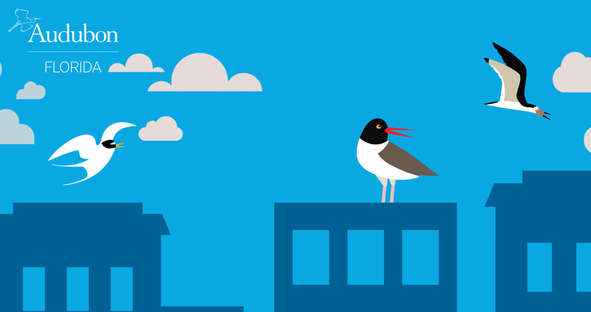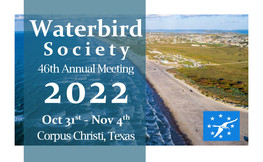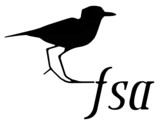Beach Stewardship Training:
April 4: Cayo Costa/Stump Pass virtual training. Email Rochelle Streker.
April 5 & 16: Collier County virtual and in-person training. Email Rochelle Streker.
April 7 & 15: Lee County virtual and in-person training. Email Rochelle Streker.
April 7: St. Johns/Flagler Partnership in-person training. Email Chris Farrell.
April 8: St. Timucuan Partnership in-person training. Email Chris Farrell.
Events:
April 2: Bunch Beach Shorebirds with Audubon of Southwest Florida.
Reminder:
April 15 - 21 is the April count window for the Breeding Bird Protocol. Whenever possible, weekly surveys are preferred for routes with active nesting; it helps capture information about peak counts.
 Audubon Florida and National Audubon Society
Launch New Rooftop-nesting Video
In early 2022, Audubon Florida and the National Audubon Society launched a new rooftop-nesting video to teach visitors and locals alike about these unique nesting areas for seabirds and shorebirds. Many people don’t know that in Florida some threatened shorebird and seabird species use gravel rooftops to raise their young. Seabirds and shorebirds prefer open, sandy beaches to breed but some birds have adapted to rooftops out of necessity. Gravel rooftops provide an alternative habitat, allowing birds to escape pressures from coastal development, human disturbance, and predators.
Audubon Florida has a long history of coordinating rooftop conservation efforts in the state. For Suncoast Rooftop Nesting Biologist, Kara Cook, the idea for the video arose out of a recurring need to locate rooftops with nesting activity. “It’s my hope that by spreading awareness about gravel rooftops we may find new active rooftops during the breeding season. The National Audubon Society and Audubon Florida shared the video on social media platforms, and plan to further share the video with landowners and property managers if a site becomes active; in turn, they can share with their employees or residents,” Kara said. The video features shorebird and seabird nesting biology, ways the birds have adapted to rooftop-nesting, and efforts that help the birds succeed. Currently available on social media, the video is a useful and easy educational tool to share and will be added to Audubon Florida’s resources for rooftop education.
Video production was led by Zakiyyah Madyun, a Walker Visual Storytelling Fellow with the National Audubon Society. Kara recognized Zakiyyah’s talent and passion for storytelling on a previous project and knew she would create an engaging and educational rooftop-nesting video. On collaborating to produce the video, Kara said, “Zakiyyah was able to take my ideas, photos, and videos of rooftop nesting and pull it all together to create a wonderful, educational video that describes the plight of rooftop nesters and what we do to protect to them.”
Audubon Florida is grateful to the National Audubon Society for video production support. Audubon encourages people to view and share the video on social media here. Additionally, anyone interested in getting involved with the rooftop program can send an email to flconservation@audubon.org and you’ll be connected with a biologist in your area.

46th Annual Meeting of The Waterbird Society
The 46th Annual Meeting of The Waterbird Society will be held in Corpus Christi, Texas during the week of October 31 – November 4, 2022.
Meeting details are updated on the Society’s website. If you are interested in organizing a symposium, workshop, or special session during the meeting, please contact Ricardo Zambrano, Chair of the Scientific Program, by May 1, 2022 at ricardo.zambrano@waterbirds.org.
Important dates:
- May 1: Abstract submissions open
- July 1: Early bird registration ends
- August 30: Abstract submissions close
- September 30: Last day to reserve hotel room at Omni to receive society’s group rate
The Local Committee and Scientific Program Committee is planning a robust meeting full of engaging plenaries and presentations, events for students and activities that promote diversity and inclusion, and exciting field trips. The 46th Annual Meeting will have a virtual component for those unable to attend the meeting in-person.
|

Florida Shorebird Database Webinars and Resources
The 2022 Florida Shorebird Database (FSD) webinar recordings are now available online! The webinars walk you through how to survey rooftops and routes using the Breeding Bird Protocol and how to enter data into the FSD. Click the links below or visit the Resources tab on the FSD website to view the recordings.
New Route Surveyors Webinar
Returning Route Surveyors Webinar
Rooftop Monitors Webinar
The webinars reference several great resources that you can find on the FSA and FSD websites. Below are just a few of examples of some of the great resources available to you!
Need datasheets or the most up to date copy of the Breeding Bird Protocol? You can find these under the FSD’s Resources tab.
Do you need guidance on aging shorebird and seabird chicks? Check out the Monitoring Guidance page on the FSA’s website. Here you can find aging guides specific to some of the common species nesting in the state. Also check out the Timing of Ground Nesting and Flightless Chicks to see what time of year you may expect to start to seeing chicks.
Not sure if black skimmers are scraping or have nests? It can be tricky to identify nesting behavior for this species. Check out the Guide to Black Skimmer Nesting and Courtship Behaviors for tips!
Looking for educational materials about Florida’s shorebirds and seabirds? Check out the Outreach Materials page where you can find shorebird themed craft ideas for kids, fun species fact sheets, and brochures on how everyone can help to share the beach with nesting birds!

Avian Influenza Resources
In February, Highly Pathogenic Avian Influenza (HPAI) was confirmed in wild birds in Florida. The FWC is monitoring for HPAI in birds found sick or dead of unknown causes. The FWC asks the public not to handle sick or dead birds, however, the public is encouraged to report all sightings of dead birds to the bird mortality database. Additional information and resources can be found on the FWC Avian Influenza page.
|
|